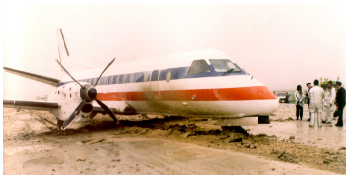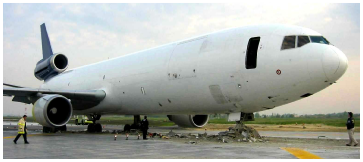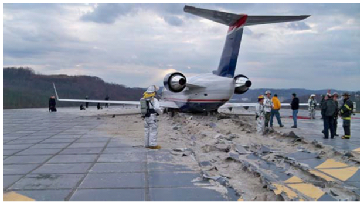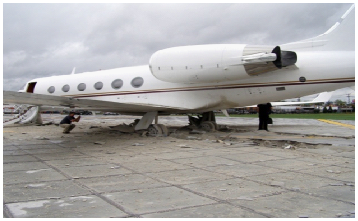









UK representative for ESCO


These excerpts from FAA fact sheets list some arrestments safely completed by ESCO' EMASMAX®. In all cases, the runway reopened within a few hours and the aircraft went back flying. Below are details on some of the arrestments. In all cases, the common features are present, little or no damage to the aircraft and all lives saved.

Arrestment Number: 1 Date: May 1999
Location: New York JFK International Airport (JFK) Runway 04R
Aircraft Type: SAAB-340 Turboprop Passenger Aircraft
R/W Exit Speed: 75 Knots
Weather Conditions: Rain – Wet Pavement
EMAS System: 114 foot setback, 392 foot long bed
RESA Length: 550 feet to Thurston Basin (Waterway)
Summary: Aircraft landed approximately 5,000 feet down the 8,400 foot runway in a rain storm. Aircraft could not stop on runway and entered EMAS system at an estimated speed of 75 Knots. Aircraft was arrested with no passenger/crew injuries and minimal damage to propeller blades.


Arrestment Number: 2 Date: May 2003
Location: JFK Runway 04R
Aircraft Type: MD11
R/W Exit Speed: 30 Knots
Weather Conditions: Rain – Wet Pavement
EMAS System: 114 foot setback, 392 foot long bed
RESA Length: 550 feet to Thurston Basin (Waterway)
Summary: Aircraft landed approximately 4,000 feet down the 8,400 foot runway in a rain storm. Aircraft could not stop on runway and entered EMAS system at an estimated speed of 30 Knots. Aircraft was arrested with no crew injuries and no aircraft damage.


Arrestment Number: 6 Date: January 2010
Location: Yeager Airport, Charleston, West Virginia
Aircraft Type: Canadair Regional Jet CRJ-200
R/W Exit Speed: Approx 55 Knots
Weather Conditions: Overcast Skies- Dry Pavement
EMAS System: 50 foot setback, 405 foot long bed
RESA Length: 455 feet
Summary: On January 19, 2010, PSA Airlines (d.b.a. US Airways Express) flight rejected the takeoff and ran off the end of runway 23. The airplane stopped in the engineered materials arresting system (EMAS) installed in the safety area.here were no injuries to the 31 passengers or 3 crew members onboard and the aircraft received minor damage. Runway was reopened in less than 6 hours.


Arrestment Number: 7 Date: October 2010
Location: Teterboro Airport, Teterboro, NJ
Aircraft Type: Gulfstream IV
R/W Exit Speed: Approx 40-50 Knots
Weather Conditions: Overcast Skies- Dry Pavement
EMAS System: 35 foot setback, 290 foot long bed
RESA Length: 455 feet
Summary: On Friday afternoon, October 1st, at 1:45 PM, a Gulfstream G-IV private jet with nine passengers and three crew members on board was safely stopped by an ESCO' EMASMAX arrestor bed installed at the departure end of runway 6 at Teterboro Airport. The aircraft’s flight began in Toronto and ended in Teterboro when it touched down, then proceeded to exit the runway at an estimated 40-50 knots, before penetrating approximately 80 ft into the length of the EMAS bed. An intermittent trail of skid marks on the tarmac followed the aircraft, which stopped less than 300 feet from Route 46, a busy six-lane highway.


Arrestment Number: 3 Date: January 2005
Location: New York JFK International Airport (JFK) Runway 04R
Aircraft Type: B747-200 Cargo Aircraft
R/W Exit Speed: 70 Knots
Weather Conditions: Snow – Snow Covered Pavement
EMAS System: 114 foot setback, 392 foot long bed
RESA Length: 550 feet to Thurston Basin (Waterway)
Summary: Aircraft landed approximately 1,500 feet down the 8,400 foot runway in a major snow storm. Aircraft could not stop on runway and entered EMAS system at an estimated speed of 70 Knots. Aircraft was arrested with no crew injuries and no aircraft damage.

Arrestment Number: 8 Date: November 2011
Location: Key West, FL
Aircraft Type: Cessna Citation 550
R/W Exit Speed: Approx. 90 kts.
Weather Conditions: Sunny Skies- Dry Pavement
EMAS System: 35 foot setback, 340 foot long bed
RESA Length: 375 feet
Summary: The overrun took place on Thursday, Nov. 3 at 12:15 PM, when a Cessna Citation 550 skidded 179 ft off the east end (Runway 09) of the 4,800-ft runway and engaged a ESCO' EMASMAX Engineered Material Arresting System. The energy-absorbing arrestor bed brought the private jet aircraft to a safe, controlled stop. The pilot, co-pilot and three passengers quickly exited the aircraft with no injuries. The aircraft suffered only minimal damage.





















